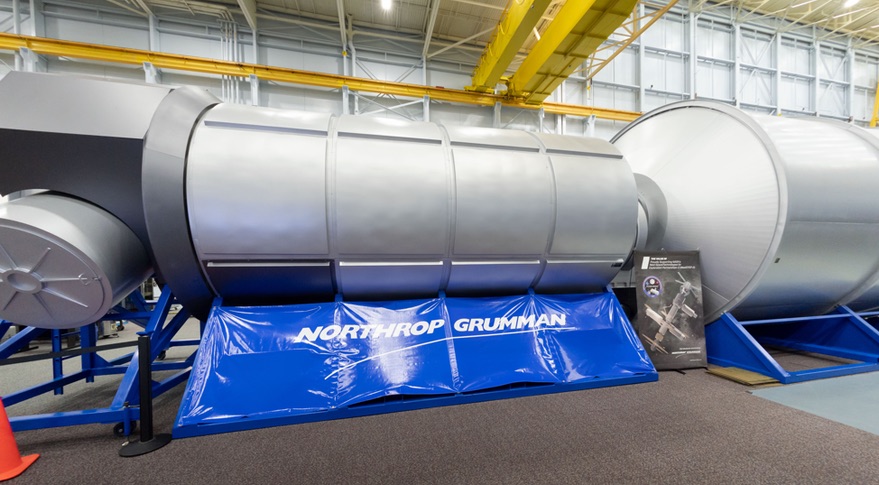
WASHINGTON — NASA has quietly decided to give Northrop Grumman a contract to build a “minimal” habitation module for its lunar Gateway after concluding it was the only company that could meet NASA’s schedule.
The agency made the determination in a low-key “Justification for Other Than Full and Open Competition” document published late July 19 on a procurement website, linked a special notice issued May 30 that stated that NASA intended to use an existing Next Space Technologies for Exploration Partnerships 2 (NextSTEP-2) program to procure the habitation module.
Under NextSTEP-2 Appendix A, NASA made awards in August 2016 to study concepts for habitation modules to six companies: Bigelow Aerospace, Boeing, Lockheed Martin, NanoRacks, Orbital ATK (now Northrop Grumman Innovation Systems, or NGIS) and Sierra Nevada Corporation. For all but NanoRacks, that work involved the development of ground prototypes followed by testing, which took place earlier this year at either NASA centers or company facilities.
In the May 30 filing, NASA said that, in “the interest of schedule, economy and efficiency,” it would procure one or more habitation modules it requires for the Gateway as a follow-on to NextSTEP-2 Appendix A. It didn’t specify the process by which it would select the company or companies to build those modules, beyond the use of justifications for other than full and open competition. It did allow other companies to submit information about their capabilities by June 13, but according to the agency none did so.
In the July 19 justification, NASA said it concluded Northrop Grumman was the only company that could provide a “minimal habitation module” on the agency’s desired schedule. “NGIS was the only NextSTEP-2 contractor with a module design and the production and tooling resources capable of meeting the 2024 deadline,” the document stated.
NASA reached that conclusion, it stated, based on three factors. One is that Northrop’s proposed habitation module is based on its Cygnus cargo spacecraft, which is in active production. The second was that the company had made sufficient progress on major changes to the Cygnus needed for use as a habitation module, including the addition of radial docking ports and body-mounted radiators. A final factor is that the small size of the module enables it to be launched on commercial launch vehicles with existing payload fairings.
NASA ruled out a full and open competition, or one restricted to just the NextSTEP-2 companies, because of schedule constraints. To be available to support the Artemis 3 mission in 2024, which will be the first crewed mission to the Gateway as well as the mission that will attempt the first crewed landing on the moon since Apollo, the module needs to be in place at the Gateway by early 2024, and thus launch by late 2023. That required the module to be completed and delivered to the Kennedy Space Center for launch processing in mid-2023.
NASA said a full and open competition for the habitation module would create “unacceptable delays” of 12 to 18 months, while limiting competition to just NextSTEP-2 companies would still create a delay of up to six months. The agency also said reaching “sufficient design maturity” once a module was selected in those competitions would add another six to 12 months. “Rushing the design and development processes to meet schedule introduces unacceptable risk that the resultant module would not meet the minimum requirements for astronaut habitation needed to support the 2024 lunar landing mission,” the agency concluded.
The justification document is not itself a contract for the module. Northrop Grumman will have to submit a proposal to NASA that the agency will review “to verify that the overall price is fair and reasonable.” If NASA finds that to be the case, it will provide a contract with a five-year base period to cover development of the module and delivery to the Gateway, as well as two one-year options for checkout of the module and support of operations there.
The justification document included an estimate of the total value of the module, but the specific dollar value was redacted. Northrop has already received $18 million through its NextSTEP-2 award, while NASA overall has provided $87 million to all the companies involved as well as “significant” expenses incurred through the use of government facilities and equipment supporting that work.
The document provided few details about Northrop’s specific module design, other than it is based on the Cygnus module. The company, as part of its NextSTEP-2 award, developed two habitation module prototypes: one seven meters long and 4.4 meters in diameter, and the other six meters long and three meters in diameter.
The latter version is derived from the Cygnus spacecraft and is likely the one referred to in the document. During a panel discussion at the Humans to Mars Summit here in May, Mike Fuller of Northrop Grumman mentioned the two module prototypes, then being tested at the Johnson Space Center. The two mockups, he said, were intended “to give NASA a feel for what the volume constraints are for the various different sizes.”
“If you really want to go minimalist,” he added, “a three-meter pressure vessel would be relatively easy for us to produce on the current production line.”
Bagikan Berita Ini















0 Response to "NASA to sole source Gateway habitation module to Northrop Grumman - SpaceNews"
Post a Comment